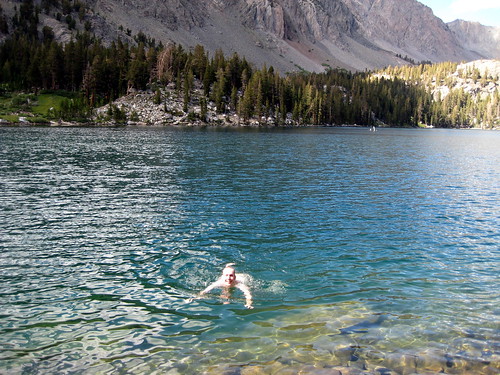Red's Meadow (thrilling conclusion!)
Aug. 22nd, 2008 12:45 am
Forest service horses grazing near Red's Meadow
Red's Meadow Resort consists of a pack station, a small cafe, a small store, and a few small 11'x14' cabins. I hadn't been there in a decade, and yet it was exactly as I remembered. There is a little piece of lawn between the store and the cafe, a pay phone, and some sections of logs you can sit on. It is where you find all the backpackers who have just come in from long trips in the wilderness, who are enjoying ice cold beers and sodas and Gatorade and ice cream and, if they are really long distance hikers, maybe picking up cached food and mail. We got that Gatorade we'd been craving. And then some sodas.
And, sitting on the hitching post, drinking our gatorade, who should come sauntering up across the parking lot?
The cowboys.
We were old friends by that point. Said our Howdys.
It turns out it was Saturday (we had reckoned Sunday!) and apparently Red's Meadow hosts a barbecue every Saturday at six in the evening. We eagerly signed up for that night's BBQ. 20 bucks for all the ribs, tri-tip, chicken, corn, bread, salad, potatoes, cobbler, and other fixings you want. It sounded like a deal.

Red's Meadow bath house, photo by flickr user surfingcat
In the meantime we wandered over to the campground where a bathhouse was built decades ago at the site of a hot spring, providing hot spring showers to eager campers.
Refreshed by our shower, we set out again for the BBQ. On the way we struck up a conversation with some hikers who had just finished a hike all the way from Yosemite who invited us to camp with them at the walk-in campground. We almost put our packs down there but thought, "Who knows what will come up?" (Maybe we'll camp with the cowboys again?) We took a back trail back to the resort, put our packs down, and set about enjoying the BBQ.
We picked a table with some friendly looking folks. "Mind if we join you?" Turned out they were not fellow tourists but employees of the resort / pack station.


We ended up sitting at that table long into the night in the company of several employees and the cowboys enjoying whiskey and a seemingly endless supply of Sierra Nevada. One of the employees in particular befriended us, and invited us to spend the night in his cabin. In the morning our new friend, Dave, treated us to breakfast at the cafe. We stayed so long talking we nearly got lunch too. Then we threw our packs into Dave's truck and he gave us a lift the mile or two to the postpile.


After a brief visit to the postpile itself, we boarded the shuttle bus up to Minaret summit (where we paid a $14 'transportation fee' to leave the park) and then to the Mammoth Mountain ski area, a sort of hellish staging area for boisterously corporate Outdoor Activities.
There is a free shuttle bus from mammoth mountain down to the town of Mammoth, and from there there is a free Mammoth trolley that would take us most of the way to the trailhead where we had parked our car. But we were impatient and opted to stick out our thumbs while waiting for the bus. First car we saw, we put out our thumbs, and it pulled right over. Retired couple from Nevada cheerfully drove us all the way to our car at the Duck Pass trailhead. And then we drove back to Los Angeles.
A pretty fine trip:
* wilderness hiking
* swimming in lakes and rivers every day
* hot springs
* cowboys with steaks and whiskey
* BBQ
* impromptu couchsurfing
* hitchhiking
* ...
Hiking itinerary:
| Segment | Distance | Climb/descent |
|---|---|---|
| Duck lake trailhead to Pika lake | 5 miles | 1700 ft climb |
| Duck lake to Purple Lake to Iva Bell Hot Springs | 14.5 miles | 3350 ft descent |
| Iva Bell to Cold Ck | 7 miles | 800 ft descent, 1000 ft climb |
| Cold Ck to Red's Meadow | 6 miles | pretty flat |
| 33 miles |


















